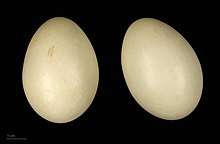Brazilian teal
The Brazilian teal or Brazilian duck (Amazonetta brasiliensis) is the only duck in the genus Amazonetta.
| Brazilian teal | |
|---|---|
 | |
| Scientific classification | |
| Kingdom: | Animalia |
| Phylum: | Chordata |
| Class: | Aves |
| Order: | Anseriformes |
| Family: | Anatidae |
| Subfamily: | Anatinae |
| Genus: | Amazonetta von Boetticher, 1929 |
| Species: | A. brasiliensis |
| Binomial name | |
| Amazonetta brasiliensis (Gmelin, 1789) | |
| Subspecies | |
| |

Taxonomy and systematics
It was formerly considered a perching duck, but more recent analyses indicate that it belongs to a clade of South American dabbling ducks which also includes the crested duck, the bronze-winged duck, and possibly the steamer ducks.[2] There are two subspecies:
- A. brasiliensis brasiliensis (lesser Brazilian teal), the nominate race, found in Brazil, Suriname, Guyana, French Guiana, central Venezuela, eastern Colombia, and northeastern Peru.[3]
- A. brasiliensis ipecutiri (greater Brazilian teal), found in Brazil, Northern Argentina, eastern Bolivia, Uruguay, and Paraguay.[3]
Description
The ducks are light brown in colour. Drakes distinguish themselves from females in having red beaks and legs, and in having a distinctive pale grey area on the side of its head and neck. The colour of these limbs is much duller in females.
Habitat and distribution
They can be found throughout eastern South America, from Uruguay, to northern and eastern Argentina, Paraguay, central Venezuela, Brazil, northeastern Peru, Suriname, Guyana, French Guiana, eastern Bolivia, and eastern Colombia.[1][3] Their preferred habitat is a body of freshwater away from the coast with dense vegetation nearby.
Behaviour
Brazilian teal live in pairs or in small groups of up to twenty birds. Both parents look after their hatchlings. They eat seeds, fruits, roots and insect, while ducklings eat only insects.
Status
They are plentiful and are listed as of Least Concern.[1]
References
- BirdLife International (2012). "Amazonetta brasiliensis". IUCN Red List of Threatened Species. 2012. Retrieved 26 November 2013.CS1 maint: ref=harv (link)
- Johnson, Kevin P. & Sorenson, Michael D. (1999). "Phylogeny and biogeography of dabbling ducks (genus Anas): a comparison of molecular and morphological evidence" (PDF). Auk. 116 (3): 792–805. doi:10.2307/4089339.
- Clements, James, (2007) The Clements Checklist of the Birds of the World, Cornell University Press, Ithaca.
External links
![]()
